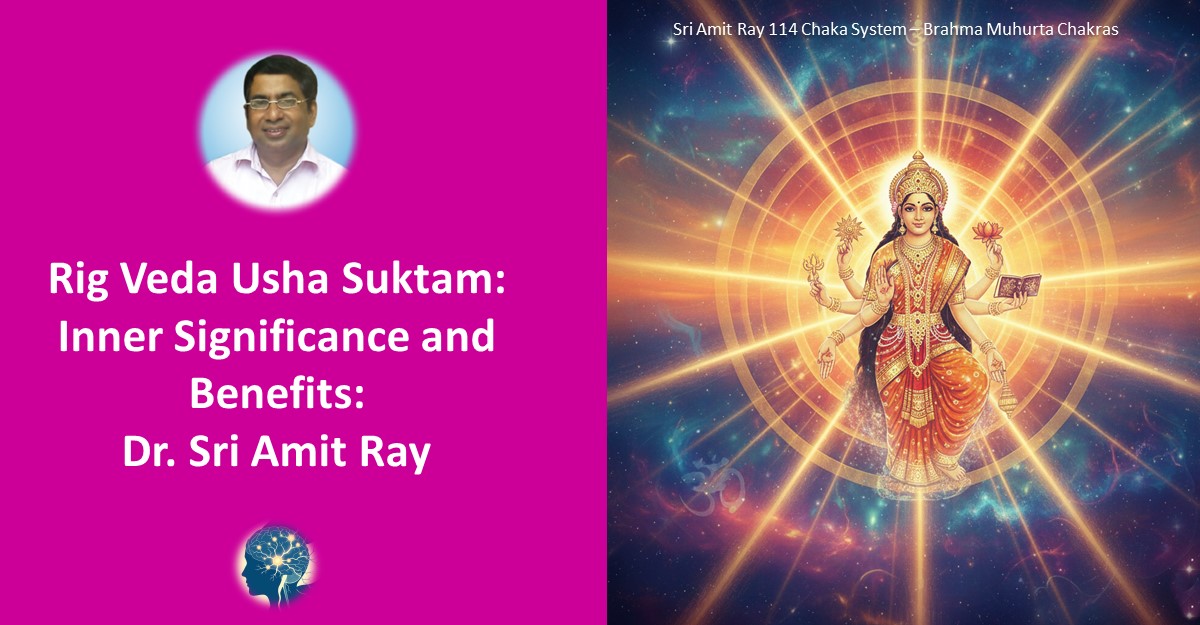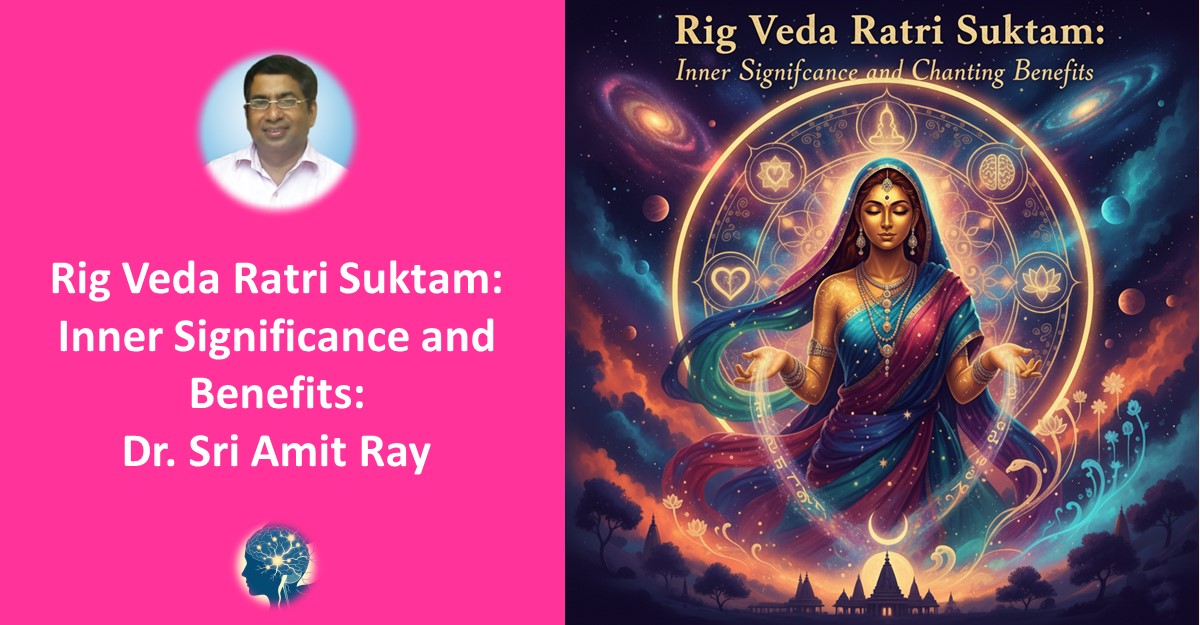The Usha Suktam (Ushas Sukta) is a hymn from the Rig Veda dedicated to Usha, the goddess of dawn. It celebrates the physical dawn as a source of light and life, and metaphorically represents awakening, consciousness, and enlightenment. The hymns describe Usha's radiant, life-giving light as a force that dispels darkness and brings prosperity, and they are a key part of Vedic literature.

Here is an in-depth exploration of the ancient Vedic hymn dedicated to Ushas Devi, the divine embodiment of dawn, focusing on Rig Veda Mandala 3, Sukta 61. Both Ratri Suktam,and Usha Suktam works together.
What is Ushas Sukta?
The Ushas Sukta, also known as the Hymn to Dawn, is a sacred Vedic hymn from the Rig Veda dedicated to Ushas, the goddess of dawn. This particular sukta, found in Mandala 3, Sukta 61, consists of seven verses composed by Rishi Vishvamitra. Ushas is personified as a radiant, youthful goddess who heralds the arrival of light, dispelling darkness and awakening the world to life and activity. She symbolizes renewal, enlightenment, and the cyclical nature of time, bringing cheer, prosperity, and order to the cosmos. The hymn invokes her blessings for illumination, both literal and metaphorical, and is chanted to attune oneself to the rhythms of nature and divine order.
Origin
The Ushas Sukta originates from the Rig Veda, the oldest of the four Vedas, composed between 1500–1200 BCE in ancient India. It appears in Mandala 3, Sukta 61, attributed to the sage Vishvamitra Gathina. Ushas is one of the most frequently hymned deities in the Rig Veda, with about 20 hymns dedicated to her across various mandalas, reflecting her importance in Vedic cosmology. The Vedas were revealed to rishis through profound meditation, capturing cosmic truths as vibrational mantras (shruti). Compiled by Vyasa, these hymns deify natural phenomena, portraying Ushas as the daughter of Dyaus (Sky), sister of Ratri (Night), and consort or associate of Surya (Sun). Her hymns emphasize the transition from night today, symbolizing the victory of light over darkness and the maintenance of Rta (cosmic order).
1. Introduction
The Uṣā Sūktam of the Rig Veda is one of the most exquisite hymns of early human spirituality — a luminous celebration of Uṣā, the Goddess of Dawn. She is the bringer of light, awareness, and renewal, the first herald of life each morning, and the embodiment of awakening in both the cosmos and the human soul. The ancient seers saw in her gentle radiance not just the physical sunrise but the inner dawn of consciousness that dispels the darkness of ignorance and sorrow. Her verses, sung in the early morning, invite the mind to awaken from inertia and align with the rhythm of divine intelligence.
2. Vedic Context of Uṣā
In the Rig Veda, Uṣā is one of the most frequently praised goddesses. She is described as “daughter of the sky” (Divas Duḥitā), “bringer of light”, and “awakener of beings”. Each morning she rides her shining chariot across the heavens, scattering darkness and revealing the world anew. Yet, she is more than a natural phenomenon. The Vedic sages experienced her as the living current of conscious awakening — the power that transitions the world from the unseen to the seen, from potential to manifestation. Her presence marks the moment where sleep transforms into perception, where rest becomes creation.
Uṣā is closely associated with Sūrya, the Sun God, but she precedes him — preparing the path for his brilliance. She is the threshold deity, standing between night and day, the unknown and the known, the hidden and the revealed. Thus, she governs the sacred liminal state between sleeping and waking, ignorance and wisdom, inertia and aspiration.
3. Symbolism and Inner Meaning
Symbolically, Uṣā represents the illumination of the inner mind. The dawn she brings is not merely external sunlight but the light of insight, clarity, and inspiration. The darkness she dispels is not only night but confusion, forgetfulness, and delusion. As she unveils the world each morning, she also unveils the truths hidden in the heart of the seeker.
Psychologically, Uṣā governs the awakening of intelligence and hope. When the Uṣā principle is active, the mind becomes luminous, receptive, and self-aware. Emotionally, she represents the emergence of joy and creative enthusiasm after the stillness of rest. Spiritually, she is the dawn of realization — the first light of divine awareness after the long night of ignorance. Her light does not burn or dazzle; it heals, reveals, and inspires.
4. Uṣā and Rātri: The Rhythms of Consciousness
In the Vedic worldview, Uṣā and Rātri (Night) are twin sisters — two eternal forces that alternate in divine rhythm. Rātri gathers the world into repose; Uṣā releases it into light. Rātri heals through stillness; Uṣā awakens through movement. The human being lives through their harmony: one brings rest and introspection, the other, clarity and expression.
Yogically, they correspond to the Idā and Piṅgalā channels, the lunar and solar currents of breath and energy. Rātri’s cool inward current nourishes silence and intuition; Uṣā’s bright outward current awakens awareness and expression. When both are balanced, the central channel — Suṣumṇā Nāḍī — opens, leading to the awakening of higher consciousness. Thus, Uṣā Sūktam and Rātri Sūktam together express the complete cycle of consciousness — repose and radiance, dissolution and creation, night and dawn within the yogic mind.
5. Uṣā and the Sixteen Moon Chakras of the Sri Amit Ray Tradition
In the Sri Amit Ray system of Sixteen Moon Chakras, Uṣā symbolizes the ascending wave of lunar light within consciousness — the inner dawn currents that awaken clarity, intuition, and compassion. The sixteen moon chakras, extending from the crown to the heart and base, represent phases of the mind’s luminosity. Uṣā awakens the upper moon centers — especially near the brow and crown — initiating the rise of awareness from rest to reflection, from receptivity to radiance. When meditated upon in the early morning, the Uṣā energy refines the neuro-hormonal rhythms, balancing serotonin and soma flows, and opens the higher intuition centers of the brain.
6. The Uṣā Chakra and the Dawn Currents
The Uṣā Chakra, located in the luminous frontal field of the subtle body, governs the inner dawn — the transition from mental darkness to perception. It awakens the brain’s right-prefrontal clarity, the seat of optimism, and harmonizes the reticular activating system that governs wakefulness and attention. When this chakra is activated through mantra and meditation, the practitioner experiences heightened lucidity, joy, and insight. It represents the gentle arousal of consciousness without agitation — a calm awakening that leads to spiritual intelligence. In the physiology of light, Uṣā Chakra corresponds to the neurochemical shift from melatonin to serotonin dominance, signaling the body and mind to awaken in harmony with the rising sun.
7. Selected Verses and Inner Interpretation
One of the most celebrated verses of the Uṣā Sūktam (Rig Veda 1.113.9) proclaims:
“Uṣā adarśi bhānunā, ā yātī śubhrayā śriyā” — “Dawn has appeared with her radiance; she advances with her bright beauty.”
Here, bhānunā signifies not just physical brilliance but the illumination of awareness. The dawn of Uṣā is the dawning of self-knowledge. Her śrī — her beauty — is the graceful harmony of mind and spirit that arises when one awakens into truth. Every morning, she reminds the seeker that renewal is always possible, and that darkness, no matter how long, always yields to light.
8. Psychological and Spiritual Benefits
Chanting or meditating upon the Uṣā Sūktam brings profound mental and emotional transformation. It enhances clarity, resilience, and inner confidence. The mind becomes radiant yet calm, the heart open yet grounded. Emotional stagnation dissolves, giving way to creative optimism and a renewed sense of purpose. The rhythm of the verses entrains the brain’s oscillations toward alpha-theta coherence — a state conducive to insight and learning.
Spiritually, the Uṣā Sūktam awakens the dawn within consciousness — the first glimmer of realization that precedes enlightenment. Through her light, the practitioner perceives the world not as chaos but as a divine orchestration. She represents the śakti of awakening — the living intelligence that transforms sleep into awareness, darkness into insight, and habit into meditation.
9. Chanting Benefits and Practice
Chanting the Uṣā Sūktam at sunrise harmonizes the body’s biological clock, enhances circadian rhythm stability, and uplifts mood and vitality. The vibration of her mantra stimulates the frontal and pineal regions, balancing melatonin, serotonin, and cortisol levels. Regular recitation refines speech, increases alertness, and restores emotional equilibrium. The sound “Uṣā” itself carries a soft, upward resonance that invokes awakening without tension — a sound of compassion and luminosity.
Yogic practitioners often combine Uṣā Sūktam recitation with gentle pranayama and early-morning meditation facing the east. In the Sri Amit Ray meditation lineage, this is synchronized with the Uṣā Chakra breathing cycle — slow inhalation with awareness of inner light rising, and exhalation dissolving into peace. This rhythm strengthens neural coherence, heart resonance, and intuitive clarity — bridging the spiritual and biological dawn.
The Slokas
Below are the original Sanskrit slokas of the Ushas Sukta (Rig Veda 3.61) in Devanagari script. Each verse is a powerful mantra invoking the goddess of dawn.
उषो वाजेन वाजिनि प्रचेताः स्तोमं जुषस्व गृणतो मघोनि । पुराणी देवि युवतिः पुरंधिरनु व्रतं चरसि विश्ववारे ॥१॥
उषो देव्यमर्त्या वि भाहि चन्द्ररथा सूनृता ईरयन्ती । आ त्वा वहन्तु सुयमासो अश्वा हिरण्यवर्णां पृथुपाजसो ये ॥२॥
उषः प्रतीची भुवनानि विश्वोर्ध्वा तिष्ठस्यमृतस्य केतुः । समानमर्थं चरणीयमाना चक्रमिव नव्यस्या ववृत्स्व ॥३॥
अव स्यूमेव चिन्वती मघोन्युषा याति स्वसरस्य पत्नी । स्वर्जनन्ती सुभगा सुदंसा आन्ताद् दिवः पप्रथा आ पृथिव्याः ॥४॥
अछा वो देवीमुषसं विभातीं प्र वो भरध्वं नमसा सुवृक्तिम् । ऊर्ध्वं मधुधा दिवि पाजो अश्रेत् प्र रोचना रुरुचे रण्वसन्दृक् ॥५॥
ऋतावरी दिवो अर्कैरबोध्या रेवती रोदसी चित्रमस्थात् । आयतीमग्ने उषसं विभातीं वाममेशि द्रविणं भिक्षमाणः ॥६॥
ऋतस्य बुध्ने उषसामिषण्यन् वृषा मही रोदसी आ विवेश । मही मित्रस्य वरुणस्य माया चन्द्रेव भानुं वि दधे पुरुत्रा ॥७॥
IAST Transliteration
The IAST provides a Romanized version for pronunciation and study.
uṣo vājena vājini pracetā stomaṃ juṣasva gṛṇato maghoni | purāṇī devi yuvatiḥ purandhiranu vrataṃ carasi viśvavāre ||1||
uṣo devyamartyā vi bhāhi candrarathā sūnṛtā īrayantī | ā tvā vahantu suyamāso aśvā hiraṇyavarṇāṃ pṛthupājaso ye ||2||
uṣaḥ pratīcī bhuvanāni viśvordhvā tiṣṭhasyamṛtasya ketuḥ | samānamarthaṃ caraṇīyamānā cakramiva navyasyā vavṛtsva ||3||
ava syūmeva cinvatī maghonyuṣā yāti svasarasya patnī | svarjanantī subhagā sudaṃsā āntād divaḥ papratha ā pṛthivyāḥ ||4||
achā vo devīmuṣasaṃ vibhātīṃ pra vo bharadhvaṃ namasā suvṛktim | ūrdhvaṃ madhudhā divi pājo aśret pra rocanā ruruce raṇvasandṛk ||5||
ṛtāvarī divo arkairabodhyā revatī rodasī citramasthāt | āyatīmaghne uṣasaṃ vibhātīṃ vāmameṣi draviṇaṃ bhikṣamāṇaḥ ||6||
ṛtasya budhna uṣasāmiṣaṇyan vṛṣā mahī rodasī ā viveśa | mahī mitrasya varuṇasya māyā candreva bhānuṃ vi dadhe purutrā ||7||
Literal Meaning of the Shlokas
Each verse is broken down word-by-word for a direct translation, based on traditional interpretations.
Verse 1
- uṣo = O Dawn
- vājena = with vigor
- vājini = vigorous
- pracetā = intelligent
- stomaṃ = praise
- juṣasva = accept
- gṛṇato = of the singer
- maghoni = wealthy lady
- purāṇī = ancient
- devi = goddess
- yuvatiḥ = young
- purandhiḥ = full of wisdom
- anu = according to
- vrataṃ = law
- carasi = movest
- viśvavāre = all-desired
O Dawn, strong with strength, endowed with knowledge, accept the singer's praise, O wealthy mother. Thou, Goddess, ancient, young, and full of wisdom, movest, all-bounteous! as the Law ordaineth.
Verse 2
- uṣo = O Dawn
- devi = goddess
- amartyā = immortal
- vi bhāhi = shine forth
- candrarathā = with bright chariot
- sūnṛtā = pleasant voices
- īrayantī = awaking
- ā tvā = to thee
- vahantu = convey
- suyamāso = docile
- aśvā = horses
- hiraṇyavarṇāṃ = golden-colored
- pṛthupājaso = far-reaching splendor
- ye = those
Shine forth, O Morning, thou auspicious Goddess, on thy bright car awaking pleasant voices. Let docile horses of far-reaching splendour convey thee hitherward, the golden-coloured.
Verse 3
- uṣaḥ = Dawn
- pratīcī = turning to
- bhuvanāni = creatures
- viśva = every
- ūrdhvā = on high
- tiṣṭhasi = standest
- amṛtasya = immortal
- ketuḥ = ensign
- samānam = same
- arthaṃ = goal
- caraṇī = wending
- yamānā = ever
- cakram = wheel
- iva = like
- navyasyā = newly-born
- vavṛtsva = roll hither
Thou, Morning, turning thee to every creature, standest on high as ensign of the Immortal, To one same goal ever and ever wending now, like a wheel, O newly-born, roll hither.
Verse 4
- ava = letting drop
- syūmeva = reins
- cinvatī = cometh
- maghoni = wealthy Dame
- uṣā = Morning
- yāti = cometh
- svasarasya = of her sister
- patnī = Lady of the dwelling
- svarjanantī = bringing forth light
- subhagā = Wonderful
- sudaṃsā = Blessed
- āntād = from the bounds
- divaḥ = heaven
- papratha = spread
- ā pṛthivyāḥ = earth
Letting her reins drop downward, Morning cometh, the wealthy Dame, the Lady of the dwelling; Bringing forth light, the Wonderful, the Blessed hath spread her from the bounds of earth and heaven.
Verse 5
- achā = hither
- vo = invoke
- devīm = radiant Goddess
- uṣasaṃ = Morning
- vibhātīṃ = and bring
- pra vo = with reverence
- bharadhvaṃ = your hymn
- namasā = to praise her
- suvṛktim = dropping sweets
- ūrdhvaṃ = hath set
- madhudhā = in heaven
- divi = her brightness
- pājo = fair to look on
- aśret = hath beamed forth
- pra rocanā = her splendour
- ruruce = hath beamed forth
- raṇvasandṛk = her splendour
Hither invoke the radiant Goddess Morning, and bring with reverence your hymn to praise her. She, dropping sweets, hath set in heaven her brightness, and, fair to look on, hath beamed forth her splendour.
Verse 6
- ṛtāvarī = the Holy One
- divo = from heaven
- arkaiḥ = with hymns
- abodhyā = was wakened
- revatī = brightly
- rodasī = to both worlds
- citram = came
- asthāt = the wealthy Lady
- āyatīm = to Morning
- agne = Agni
- uṣasaṃ = when she comes
- vibhātīṃ = refulgent
- vāmam = thou goest forth
- eṣi = soliciting
- draviṇaṃ = fair riches
- bhikṣamāṇaḥ = soliciting
From heaven, with hymns, the Holy One was wakened: brightly to both worlds came the wealthy Lady. To Morning, Agni, when she comes refulgent, thou goest forth soliciting fair riches.
Verse 7
- ṛtasya = on Law's
- budhna = firm base
- uṣasām = the speeder of the Mornings
- iṣaṇyan = the Bull
- vṛṣā = hath entered
- mahī = mighty
- rodasī = earth and heaven
- ā viveśa = hath entered
- mahī = great
- mitrasya = of Mitra
- varuṇasya = and Varuna
- māyā = power
- candreva = which bright
- bhānuṃ = hath spread
- vi dadhe = in every place
- purutrā = its splendour
On Law's firm base the speeder of the Mornings, the Bull, hath entered mighty earth and heaven. Great is the power of Varuṇa and Mitra, which, bright, hath spread in every place its splendour.
Spiritual Meanings
The Ushas Sukta goes beyond a mere description of dawn, symbolizing spiritual awakening and the triumph of light over ignorance. Ushas represents the divine illumination that dispels the darkness of tamas (ignorance), awakening the soul to higher consciousness. As the medium of awakening, she fosters the growth of inner divine qualities, leading to realization of Truth (Satya) and beatitude. Her eternal youth and ancient wisdom signify the timeless nature of spiritual truth, encouraging adherence to Rta (cosmic and moral order). Chanting invokes inner light, purifying the mind and aligning with universal rhythms for self-realization.
Verse-wise Spiritual Insights
- Verse 1: Invokes acceptance of devotion, symbolizing surrender to divine wisdom for inner strength and bounty.
- Verse 2: Her shining chariot represents the journey of the soul towards enlightenment, drawn by pure energies.
- Verse 3: As the immortal ensign, she guides all beings to the ultimate goal, like a wheel of dharma rolling eternally.
- Verse 4: Spreading light across earth and heaven signifies the pervasive nature of divine consciousness.
- Verse 5: Invoking her radiance promotes humility and devotion, leading to spiritual sweetness and heavenly vision.
- Verse 6: Awakening with hymns reflects the call to inner fire (Agni) for wealth of knowledge and prosperity.
- Verse 7: Her power with Mitra-Varuna emphasizes cosmic order, spreading light like the moon's gentle illumination.
Significance
The Ushas Sukta holds profound significance in Vedic tradition as a celebration of renewal and cosmic order. Ushas, the most exalted female deity in the Rig Veda, embodies the daily restoration of light and life, fighting chaos and upholding Rta. Her hymns influence later Hindu philosophy, symbolizing enlightenment and the feminine divine (Shakti). Integrated into rituals like Chhath Puja, it promotes harmony with nature, ecological awareness, and the cyclical view of time. Philosophically, it teaches impermanence, the victory of knowledge over ignorance, and the interdependence of cosmic forces.
Benefits
Chanting the Ushas Sukta offers holistic benefits:
- Illumination: Dispels mental darkness, enhancing clarity, intuition, and wisdom.
- Renewal: Promotes daily rejuvenation, reducing fatigue and boosting vitality.
- Prosperity: Attracts wealth, strength, and auspiciousness by aligning with cosmic order.
- Protection: Wards off evil forces and chaos, fostering peace and harmony.
- Spiritual Growth: Aids in self-realization, purifying karma, and leading to liberation.
- Emotional Balance: Brings cheer, dispels confusion, and imparts life force to all beings.
Rituals
The Ushas Sukta is chanted at dawn to harness the energy of renewal. Key rituals include:
- Preparation: Rise before sunrise, bathe, face east, light a lamp or incense.
- Invocation: Begin with Om and sankalpa for enlightenment or prosperity.
- Chanting: Recite the seven verses 3, 7, or 108 times, using a mala; pair with Gayatri Mantra.
- Offerings: Offer water, flowers, or milk to Ushas' image; visualize her golden chariot.
- Integration: Part of Sandhya Vandana or Chhath Puja; meditate on light dispelling darkness.
- Closure: End with pranayama, offering the merit for universal welfare.
Chant during sunrise for maximum efficacy, especially on Sundays or equinoxes.
FAQ
- Which Ushas Sukta is this?
- This focuses on Rig Veda 3.61, a prominent hymn by Vishvamitra; others include 1.48 and 6.64.
- Can anyone chant Ushas Sukta?
- Yes, with proper pronunciation; beginners should learn from a guru for vibrational accuracy.
- When is the best time to chant?
- At dawn, to align with Ushas' energy; anytime for spiritual awakening.
- Does it help with mental clarity?
- Yes, it dispels ignorance and enhances focus, but combine with meditation for best results.
- What if I don't know Sanskrit?
- Use IAST or audio; intention and devotion are key to benefits.
- Is Ushas related to other goddesses?
- Yes, akin to Greek Eos and Roman Aurora; in Hinduism, linked to Lakshmi and Gayatri.


